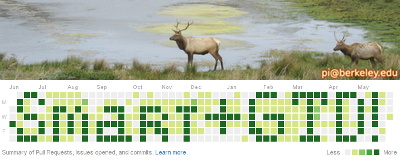Research¶
Natural Scene Statistics Reading List¶
One of my interests lies in natural scene statistics: see my quals reading list for a fairly thorough set of papers in this area.
For the time being, I will simply include an Ohloh widget of the tools I use for my scientific endeavors
Scientific Python Stack¶
See also
a great list of resources put together by Fernando Perez. |
|
neuroscience-related packages to be used on Debian systems (or Debian-derivatives like Ubuntu). I maintain the [us-ca] mirror of NeuroDebian. |
|
helps researchers be more productive by teaching them basic computing skills. We run boot camps at dozens of sites around the world, and also provide open access material online for self-paced instruction. I am a Software Carpentry instructor. |
Meetings¶
Bay Area Vision Research Day is an annual one-day meeting hosted by the Vision Science graduate program at UC Berkeley, dedicated to fostering community amongst researchers in the San Francisco Bay Area in vision-related fields including neuroscience, ophthalmology, psychology, optics, and computer vision.
Computational and Systems Neuroscience (CoSyNe) meeting provides an inclusive forum for the exchange of experimental and theoretical/computational approaches to problems in systems neuroscience.
Vision Sciences Society (VSS) annual meeting offers attendees the opportunity to learn about the latest vision research.
SciPy Conference annual week-long meeting filled with tutorials, conference talks, and developer sprints oriented around scientific computing with Python.
PyCon US largest annual gathering for the community using and developing the open-source Python programming language
PyData is a gathering of users and developers of data analysis tools in Python.
OSA Fall Vision Meeting - a small, high-quality scientific meeting focused on vision, color and noninvasive assessment techniques. It is organized in collaboration with the Optical Society of America (OSA).
Posters, Articles, Book Chapters¶
see also Google Scholar and ORCID 0009-0008-8815-6152 (only started using this ORCID in mid 2023).Andreas Klöckner, Nicolas Pinto, Yunsup Lee, Bryan Catanzaro, Paul Ivanov, Ahmed Fasih. PyCUDA and PyOpenCL: A scripting-based approach to GPU run-time code generation, Parallel Computing, Volume 38, Issue 3, March 2012, Pages 157-174, ISSN 0167-8191, 10.1016/j.parco.2011.09.001. [article]
A. Klöckner, N. Pinto, B. Catanzaro, Y. Lee, P. Ivanov, A. Fasih GPU Scripting and Code Generation with PyCUDA. in: GPU Computing Gems: Jade Edition”, Morgan Kaufmann Publishers, Waltham, MA. see http://books.google.com/books?id=LsNVFUnzcVMC [book chapter]
Ivanov, Paul and Blanche, Tim (2011, May). Improving gaze accuracy and predicting fixation in real time with video based eye trackers. Vision Science Society annual meeting. Naples, Florida. [Poster 43.405]
Rokem A, Trumpis M, Perez F, Ivanov P, Koepsell K, Blanche T, Fegen D, D’Esposito M (2010) Nitime: an open-source package for time-series analysis of neuroscience data. Poster presentation, Human Brain Mapping (HBM), Barcelona, Spain. [ Poster 784 MT-PM ]
Ivanov, Paul (2009, October). Estimating the Entropy of Natural Scenes from Nearest Neighbors using CUDA (local copy) GPU Technology Conference, San Jose, CA. [Poster #19] [You can also see the rest of the posters from that conference.]
van Hateren database¶
There was recently an email on the VisionList requesting a mirror of the van Hateren image data set. Here are all of the .iml files, which form the set of linear images. There is another set of the same images in deblurred .imc files which corrected for the optics of the camera. Both sets can be downloaded in their entirety in two separate .tgz files here.
The original description of the dataset from Hans van Hateren’s site:
Still Images
The data below can be downloaded freely for scientific, non-commercial
uses. If you publish work based on these data, please cite the article
where this collection of images and its calibration are first described:
* van Hateren, J.H., van der Schaaf, A. (1998) Independent component
filters of natural images compared with simple cells in primary
visual cortex. Proc.R.Soc.Lond. B 265:359-366. Preprint version
21/11/97: postscript 3.3 Mb, compressed postscript 1.4 Mb, PDF 1.2
Mb, abstract, demo; reprint as published: PDF 0.4 Mb
Still image collection (approximately 4000 large calibrated images,
obtained with a Kodak DCS420 camera)
Philipp Lies maintains a mirror hosted at the Max Planck Institute for Biological Cybernetics, which contains a more complete description of the data, as well as both the linear .iml and the deblurred .imc files, as well as all of the information which was present at the original website (such as the file format and how to read files into matlab).
OSA Contest 2011¶
The Optical Society of America Fall Vision Meeting is holding a Spectrum Recovery Competition. I have posted a Python port of the sample code, along with related notes.
McGill Calibrated Colour Image Database¶
As of 2011-07-06, the original location is inaccessible, Fred Kingdom was receptive to having this Mirror of McGill Calibrated Colour Image Database go up. Here’s the original description
The purpose of this database is to provide a large number of colour images of
natural scenes, calibrated, if required, for use in biological and computer
vision research. So far we have over 850 images and are increasing the number
each month.
The images are free for research, but not commercial, purposes. If you use our
images, please cite us!
Olmos, A., Kingdom, F. A. A. (2004), A biologically inspired algorithm for
the recovery of shading and reflectance images, Perception, 33, 1463-1473.
We have made every effort to make the website user friendly, and to make the
calibration routines as valid and accurate as possible. However, if you find
any errors in the website or routines, or if you have any suggestions for the
website's improvement, please let us know: fred.kingdom_at_mcgill.ca.


